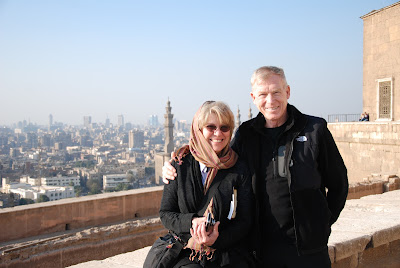Museum of Egyptian Antiquities
Back in Cairo, we visited the Museum of Egyptian Antiquities, an overwhelming museum with art, giant statues, sarcophagi, mummies, and gold everywhere—the museum houses more than 250,000 artifacts from the past 5,000 years. The animal mummy room, treasures from King Tut’s tomb, and the wooden carvings with stone eyes were some of my favorites. The folding bed Tut used for travelling (it had hinges that looked just like those on modern doors) and the board games found in King Tut’s tomb were unbelievable. It is so interesting to me how 5,000 years ago, people still liked board games and found travelling beds (with metal hinges!), useful. My mom really liked the well-preserved 4000-year-old wooden boats. The amount of treasure, high quality craftsmanship, and giant gold boxes-sarcophagi-coffins of King Tut’s tomb were also pretty incredible. Can’t quite fathom the amazement of Howard Carter must have felt when discovered the tomb in the 1920s.
In the Royal Mummies Hall, the mummies had skin, hair, and fingernails. It was easy to discern individual facial features and some looked about ready to wake up.
Coptic Cairo
Egypt is 90% Muslim, Coptic Christians make up about 9%, with other Christian denominations accounting for most of the rest. We visited the Hanging Church, a 9th century Coptic Church build on top of the Water Gate of Roman Babylon. It is named the Hanging Church for its appearance during the annual Nile floods. When the waters of the Nile rose, the church would appear to be floating, supported from below by the old Roman towers.
Below are pictures of Mahmoud, Mom, and I walking through Coptic Cairo and a mosaic from inside the courtyard at the Hanging Church depicting Mary, Joseph, and Jesus during their 3 and a half years in Egypt while Herod’s purge of baby boys.
Ben Ezra Synagogue and Abu Sirga Church
Egypt’s Jewish population numbered around 80,000 in the 1920s, but is now estimated to be as low as 200. The Ben Ezra Synagogue near the Abu Sirga Church in Coptic Cairo. It has been housed in the shell of a 4th century Christian church since the 9th century. It is supposedly built on the site where the pharaoh’s daughter found Moses in the reeds and where Mary drew water to wash Jesus.
Citadel of Salah Al-Din and Mohammed Ali MosqueThe Citadel was home to Egypt’s rulers for 900 years. Saladin started construction in 1176 AD to fortify the city against the Crusaders. The Mamluks enlarged the complex, adding harems and palaces. Mohammed Ali, an Albanian soldier in the Ottoman army who rose to power after the French departure in 1801, replaced them with the Mosque of Mohammed Ali. The Mosque of Mohammed Ali, also known as the Alabaster Mosque, was constructed in Turkish style with alabaster dominating the interior décor.
Khan El Khalili Bazaar
Khan El Khalili Bazaar, mostly geared towards tourists, it was constructed in the 14th century and lies near one of the most sacred Islamic sites in Egypt, the Mosque of Sayyidna al Hussein.
We ended our Egypt trip with a Felucca ride on the Nile.









No comments:
Post a Comment